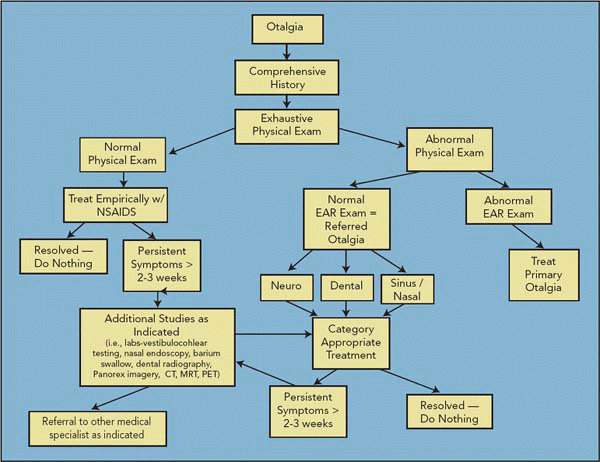Otalgia is a common complaint of patients presenting to both general practice and otolaryngology clinics. In some cases, ear pain is classified as primary otalgia, or pain that originates as the result of pathology within the ear itself. Examples of primary otalgia include external otitis, otitis media, mastoiditis, and auricular infections. Diagnosis of these conditions is fairly straightforward, and standard treatment generally alleviates the problem. However, in up to 50% of adults complaining of ear pain, the pain is the result of referred otalgia arising from non-otological disease.1 Physicians need to keep in mind the unique and complex innervation of the ear and be familiar with the myriad conditions that can result in ear pain in order to accurately diagnosis and treat the source of referred otalgia.

Referred Otalgia
The sensory innervation of the ear involves six nerves: two branches of the cervical plexus, derived from the second and third cervical roots, and four cranial nerves-trigeminal (V), facial (VII), glossopharyngeal (IX), and vagus (X).1 Noxious stimulation of any branch of these nerves by any of the structures receiving sensory input from these nerves can cause ear pain. This complex innervation can make diagnosis of the etiology of ear pain in the absence of primary ear pathology a challenge.
Because referred otalgia can be the result of a vast number of problems ranging from dental issues (e.g., temporomandibular disease) to a more serious condition requiring immediate diagnosis and intervention (e.g., hidden malignancy), the physician must use a structured, systematic approach to identify the etiology of the patient’s pain. A comprehensive history and exhaustive physical examination are crucial components of this approach. The findings of the history and physical examination will determine what interventions or additional testing may be indicated (see flowchart).
History
The physician must obtain a complete history regarding the patient’s chief complaint of ear pain. Ask the patient to describe his or her pain: onset, characteristics, severity, localization, radiation. Does anything done by the patient seem to alleviate or exacerbate the pain? It is important to remember that the severity of pain is not in any way indicative of the seriousness of pathology.
The physician should then question the patient regarding associated symptoms. For example: Does the patient suffer from tinnitus, hearing loss, vertigo, sinusitis, facial pain, myalgias, neuralgias, or arthritis?

Leave a Reply